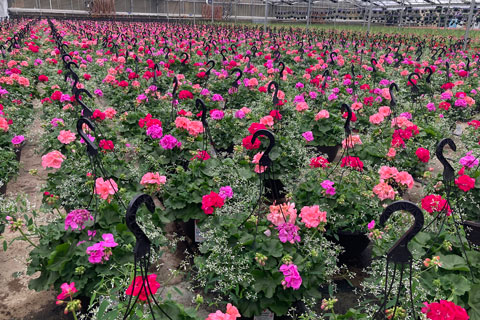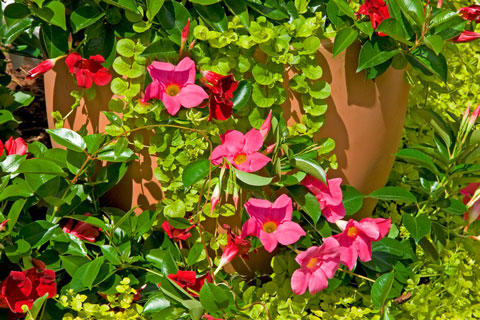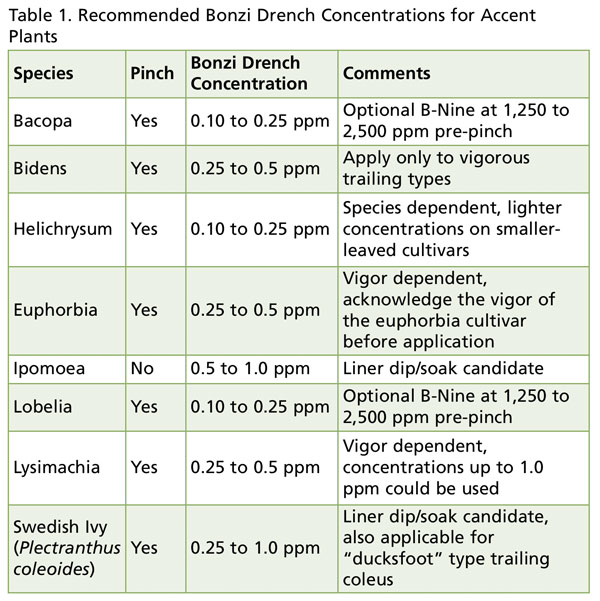3/1/2023
Fillers for Premium Combos
Jamie Gibson, Ph.D. & Alicain Carlson, Ph.D.

Madinia Dipladenia and Calliope interspecific vegetative geraniums are beautiful on their own as finished containers, but adding in a few accent plants takes your product to premium, which means a higher price point. By manipulating the liner, one can decrease inputs of the finished plant and reduce handling.
Figure 1. The euphorbia is the accent plant that delivers texture and definition to the foundation geranium in these hanging baskets.
Building plants with more flowers is the goal and growers can use lateral branching agents to develop more shoots and increase flower power. With geraniums, Florel at 350 ppm applied 14 to 17 days after sticking cuttings can increase lateral breaks. In growing dipladenia, chemical branching agents, such as Configure or Atrimmec, will help with fullness of the liner and finished plant. Configure foliar sprays at 150 to 300 ppm are recommended and trialing is encouraged with Atrimmec at 200 to 400 ppm. Configure can be applied four to five weeks after stick and one week before pinching in propagation. These ranges have improved shoot numbers of the liner without impacting rooting, plant quality or flower timing.
Adding accent plants to a container gives it a premium look and price point. It’s important to manage the growth of the accent plants effectively compared to the main showy component to make sure it doesn’t overpower or get consumed by it. Most of the time, accent plants tend to overpower and need to be trimmed, which means greater handling. The chemical treatment of accent plants with Bonzi micro-drenches in the final stages of liner production to contain the vigor can improve grower efficiency and prevent damage of the trailing growth beyond the container rim while racking, shipping and displaying at retail.
 Figure 2. Applying a Bonzi micro-drench to the lysimachia towards the end of the liner finished stage is recommended for this combo.
Figure 2. Applying a Bonzi micro-drench to the lysimachia towards the end of the liner finished stage is recommended for this combo.
There are several accent plants that complement our core greenhouse crops (several are mentioned in Table 1). Euphorbia and lysimachia are two key crops that we’ll focus on here. A notable example—the euphorbia and geranium combo in Figure 1—euphorbia being the billowy accent plant that delivers texture and definition to the foundation geranium.
Typically, euphorbia is a five- to six-week liner that’s single stuck, sprayed with B-Nine to tone and stack the internodes, then pinched mid-crop and held with a second B-Nine spray. In our experience, adding a final micro-drench of Bonzi at 0.25 to 0.50 ppm as an alternative to the final B-Nine spray may reduce its aggressive nature, delivering balance to the container. Another example—the lysimachia and dipladenia combo in Figure 2—applying a Bonzi micro-drench to the lysimachia at 0.25 to 0.5 ppm toward the end of the liner finished stage is recommended.
 Use the accent liner treatment information in Table 1 for recommendations on ways to create accent plant tidiness in combos and mixed containers. Please be mindful that transplant of the treated accent liner is also a source of PGRs for the main component, so watch the rate and concentration applied. Examples of combination caution would be with New Guinea impatiens and begonias.
Use the accent liner treatment information in Table 1 for recommendations on ways to create accent plant tidiness in combos and mixed containers. Please be mindful that transplant of the treated accent liner is also a source of PGRs for the main component, so watch the rate and concentration applied. Examples of combination caution would be with New Guinea impatiens and begonias.
The concentrations recommended in the chart are primarily micro-drench concentrations, thus not stunting the look of the basket or container. Syngenta Technical Services always suggests trialing prior to commercial implementation. GT
Jamie Gibson, Ph.D. (Technical Lead) and Alicain Carlson, Ph.D. (Head of Technical Services) are employees of Syngenta Flowers North America.